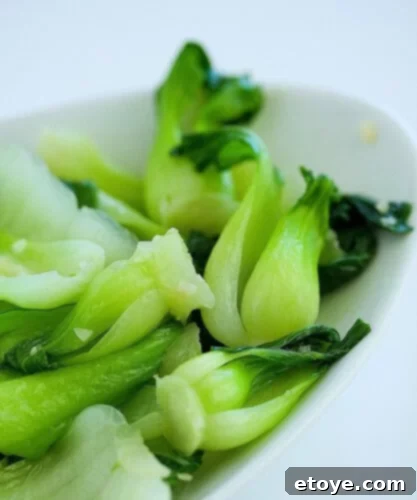Welcome to a culinary journey that celebrates one of the most underrated green vegetables: bok choy. This incredibly versatile and nutritious leafy green is a staple in Asian cuisine, revered for its crisp texture, mild flavor, and ability to soak up delicious sauces. Today, I’m thrilled to share a recipe that transforms simple bok choy into an extraordinary side dish, bursting with vibrant flavors of garlic and ginger.
Imagine a dish that is not only quick to prepare—ready in just about 10 minutes—but also tastes like it’s been expertly crafted in your favorite Chinese restaurant. This stir-fried bok choy recipe achieves exactly that. It’s a perfect blend of tender leaves and crunchy stems, bathed in an aromatic, savory sauce that will have you coming back for more. Whether you’re a seasoned chef or a kitchen novice, this easy-to-follow method will elevate your vegetable game and might just become your new favorite way to enjoy greens. Let’s dive in and discover the secrets to perfectly cooked bok choy.
Why This Stir-Fried Bok Choy Recipe Will Become Your Favorite
This isn’t just another vegetable side dish; it’s a testament to how simple ingredients, combined with smart techniques, can create something truly spectacular. Here’s why this garlic ginger bok choy stir-fry stands out:
- Achieve the Perfect Stir-Fried Texture Every Time: The key to exceptional stir-frying lies in achieving a balance of tender and crisp. This recipe masterfully cooks the bok choy leaves until they are tender-crisp, while the stems retain a delightful crunch. It’s a texture that’s both satisfying and visually appealing, showcasing the natural beauty of this green. Forget soggy vegetables; this method guarantees bok choy cooked just right, making it an ideal introduction for those new to this wonderful vegetable.
- Rich Garlic Flavor Without the Bitterness: One common pitfall in cooking with garlic is burning it, which can leave a harsh, bitter taste. Our unique technique ensures you extract every ounce of robust, aromatic garlic flavor without any hint of charring. The result is a deeply savory infusion that permeates every bite, creating a truly memorable experience that will remind you of authentic Asian cuisine.
- An Ideal, Flavor-Packed Vegetarian Side Dish: For anyone seeking a delicious and healthy vegetarian option, this recipe is a game-changer. It’s incredibly flavorful and versatile, making it a perfect accompaniment to a wide range of main courses. Its nutrient-rich profile also makes it an excellent choice for those on medically restrictive diets, proving that healthy eating can be incredibly appetizing.
- Versatility to Complement Any Main Course: The subtle yet distinct Asian flavors of this bok choy dish are designed to enhance, not overpower. Whether you’re serving it alongside grilled fish, a hearty beef stir-fry, or succulent pork, it integrates seamlessly, adding a layer of sophisticated taste and texture. It’s the ultimate flexible side dish that elevates any meal without competing for attention.
- Simple Ingredients, Easy Accessibility: You won’t need to visit specialty stores to gather ingredients for this dish. Everything required can be found at your local grocery store, making this gourmet-tasting side incredibly convenient to prepare. This recipe exemplifies the idea that truly great food doesn’t need to be complicated or call for exotic components.
- Perfect for Any Occasion: From a quick weeknight dinner to an elegant dinner party, this stir-fried bok choy fits perfectly. Its rapid cooking time and impressive flavor profile mean you can add a touch of authentic Asian flair to any meal without spending hours in the kitchen, offering both convenience and culinary delight.
Understanding Bok Choy: Varieties and Selection
Bok choy, also known as pak choi, is a type of Chinese cabbage and a beloved vegetable in many Asian culinary traditions. While often used interchangeably, there are distinct differences between regular bok choy, baby bok choy, and a similar green called Tatsoi, which can influence your cooking and enjoyment.
Bok Choy vs. Baby Bok Choy: Key Differences
- Size: The most apparent distinction is size. Baby bok choy is harvested earlier, typically when it’s about 4-6 inches long. Regular bok choy is simply a more mature plant, growing significantly larger, sometimes up to 12 inches.
- Texture and Flavor: Baby bok choy boasts a more tender texture throughout, with a milder, sweeter flavor. Its compact size means the leaves and stems are delicate and cook quickly. Mature bok choy has thicker, firmer white stems and slightly tougher green leaves, offering a more robust, earthy flavor. The stems can be quite fibrous if not cooked properly.
- Cooking Time: Due to its smaller size and delicate nature, baby bok choy cooks much faster, making it ideal for quick stir-fries and light steaming. Regular bok choy, with its thicker stems, requires a slightly longer cooking time, often benefiting from separating stems and leaves to ensure even cooking.
- Appearance: Baby bok choy typically has a more compact, cylindrical shape with tightly clustered leaves. Regular bok choy features larger, more spread-out dark green leaves and a more prominent, often thicker, white stem base.
- Culinary Usage: Both varieties are incredibly versatile. Baby bok choy is often preferred for dishes where a delicate presentation or quicker cooking is desired. Regular bok choy, with its heartier texture, stands up well to longer cooking methods or when you want a more substantial vegetable component. You can generally use them interchangeably in recipes, but adjust cooking times accordingly.
What About Tatsoi?
Tatsoi, sometimes referred to as Tat Choi, is another fantastic Asian green that shares visual similarities with baby bok choy but belongs to a different family (related to Brussels sprouts and mustard greens). It forms a beautiful rosette shape with small, spoon-shaped, dark green leaves and pale green stems. Tatsoi offers a mild, slightly sweet flavor with wonderfully tender, buttery leaves, making it excellent for quick stir-fries, salads, or gentle steaming. Its delicate nature means it cooks even faster than baby bok choy, so be mindful of cooking times.
Choosing the Freshest Bok Choy
Regardless of the variety, always look for bok choy with vibrant green leaves and firm, crisp white stems. Avoid any bunches with wilting, yellowed, or bruised leaves, or soft, discolored stems. Fresher bok choy will deliver the best flavor and texture in your dish.
Essential Ingredients for Your Stir-Fry
This recipe shines because of its simplicity and the quality of its fresh ingredients. You only need a few pantry staples to create this flavorful dish:
- Bok Choy (or Baby Bok Choy): The star of our show! Choose fresh, crisp heads as described above.
- Cooking Oil: A neutral oil with a high smoke point is best for stir-frying. Canola, vegetable, peanut, or even a light olive oil will work perfectly. It helps conduct heat and infuse flavors.
- Fresh Garlic: The backbone of the aromatic flavor. Finely minced garlic releases its full fragrance when gently cooked.
- Fresh Ginger: Adds a warm, zesty, and slightly spicy note that complements the garlic beautifully. Grating it ensures maximum flavor extraction and smooth integration.
- Water or Broth: Essential for creating a steaming environment, which helps tenderize the bok choy rapidly without overcooking. Vegetable or chicken broth adds an extra layer of savory depth.
- Soy Sauce or Salt: For seasoning and umami. Soy sauce provides a rich, salty, and slightly sweet flavor, while salt offers a clean seasoning. Adjust to your preference.
- Sesame Oil: A finishing drizzle of toasted sesame oil adds a nutty, aromatic complexity that truly defines the Asian character of the dish.
How to Master This Bok Choy Recipe: Step-by-Step Guide
Achieving restaurant-quality stir-fried bok choy is easier than you think with these simple steps and a clever technique.
Step 1: Prepare the Bok Choy
Begin by carefully trimming the very end of the bok choy stem. You don’t want to remove too much, just the tough, discolored base. This crucial step ensures that the bok choy cooks evenly, as the thick stem can otherwise remain too firm. After trimming, separate the individual bok choy leaves, taking care to keep the tender inner baby leaves intact—these are truly the “golden nuggets” of the plant, offering a delightful texture. Rinse all the leaves thoroughly under cold running water to remove any dirt or grit, then drain well.


Remember to preserve the delicate baby bok choy hearts nestled within the larger leaves! These provide a wonderful contrast in texture and taste.
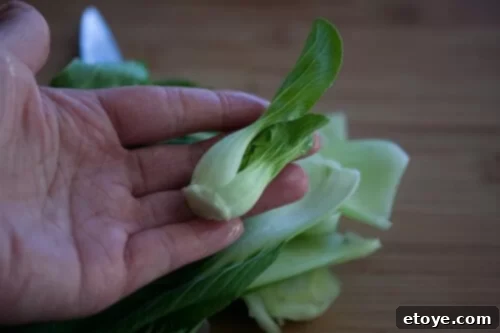
Step 2: Prepare Your Aromatics
Next, finely mince your garlic. For the ginger, use a microplane grater to achieve a finely grated texture. This method is highly recommended because it breaks down the tough fibers of the ginger, allowing its flavor to disperse evenly throughout the dish. A little tip: if your ginger is fresh with paper-thin skin, you often don’t even need to peel it before grating!

Step 3: Infuse the Oil with Garlic and Ginger (The Secret Technique!)
Place a large wok or a wide frying pan on your stove. Pour in the cooking oil. Crucially, add the minced garlic and grated ginger to the cold oil in the cold pan. Turn the heat to medium-high. This is the secret to a phenomenal flavor profile! As the pan and oil gently heat up, the aromatics will slowly sizzle, releasing their incredible flavors into the oil without burning. Watch for them to become fragrant and turn a light golden brown—this usually takes a couple of minutes.

Step 4: Stir-Fry the Bok Choy
Once the garlic and ginger are beautifully fragrant, add the prepared bok choy leaves to the wok. Immediately begin to toss and stir vigorously. You want to ensure every leaf is thoroughly coated in that heavenly garlicky, gingery oil. This step moves quickly, typically only about 15-20 seconds of rapid tossing to ensure even coating and initial cooking.



Step 5: Steam and Finish
Immediately after tossing, pour in the liquid (water, broth, or a combination including Chinese cooking wine). Cover the wok or pan tightly with a lid and let the bok choy steam for exactly 1 minute. This steaming action helps to quickly tenderize the greens while maintaining their vibrant color and slight crispness. Once steamed, remove the lid, season with soy sauce (or salt, if preferred), and drizzle a small amount of sesame oil over the top for that classic aromatic finish. Toss once more to combine and serve immediately.

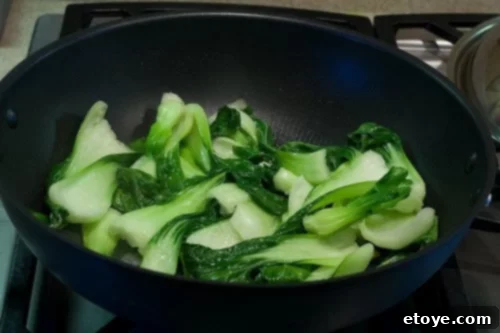
Can I Substitute Other Vegetables?
Absolutely! This stir-frying method is incredibly adaptable and works beautifully with a variety of vegetables. Feel free to experiment with other Chinese greens like Napa cabbage, yu choy, or even broccoli. For thicker vegetables such as broccoli florets or thicker cuts of cabbage, you might need to increase the steaming time by an additional minute or two and add a little more liquid to ensure they cook through evenly.
Why Tongs Are Your Best Friend for Stir-Frying Delicate Greens
You might wonder why tongs are recommended over a traditional wok spatula (chan) for this recipe. The answer lies in handling delicate vegetables like bok choy. Tongs provide superior control, making it much easier to gently toss, flip, and turn the leaves without bruising or tearing them. This ensures even cooking and prevents the bok choy from getting mashed, preserving its beautiful texture and appearance. They also allow for quicker, more efficient movement in the hot pan, which is essential for successful stir-frying.
The Culinary Secret to Unburnt, Flavorful Garlic and Ginger
The core problem with stir-frying minced garlic and ginger in a very hot wok is their tendency to burn quickly. Burnt garlic and ginger develop a distinctly bitter and astringent taste that can easily ruin the delicate flavors of a dish like bok choy. While some bitter notes can be appreciated in certain cuisines, for a fresh and vibrant bok choy stir-fry, it’s generally undesirable.
Our secret technique completely bypasses this issue: **add the minced garlic and ginger to a cold wok with cold oil.** As the wok gradually heats up, the aromatics slowly begin to sizzle. This gentle heating process allows the garlic and ginger to infuse their incredible oils and essences into the cooking oil over a longer period, without the risk of scorching. The result is a richly flavored oil, fragrant with the pure essence of garlic and ginger, that then coats every single leaf of the bok choy. This ensures a deep, consistent flavor throughout the dish, making each bite a truly aromatic delight.
Top Tips for the Best Bok Choy Stir-Fry
Follow these expert tips to ensure your bok choy stir-fry is always a triumph:
- Choose Your Bok Choy Wisely: Both regular bok choy and baby bok choy work wonderfully. Baby bok choy will be more tender and cook faster, while mature bok choy offers a heartier texture. Adjust cooking times slightly based on your choice.
- Proper Stem Trimming: Don’t be afraid to trim the very end of the bok choy stem. This ensures more even cooking for the entire plant. Remember to keep the tender inner leaves intact!
- Wok Alternative: No wok? No problem! A wide-bottomed frying pan or sauté pan with high sides will work just as well. The key is to have enough surface area for the greens to spread out and cook quickly.
- Mise en Place is Key: Stir-frying is a rapid cooking method. Have all your ingredients prepped, minced, and measured before you even turn on the heat. This ensures a smooth and stress-free cooking process.
- Cold Oil, Cold Wok: As highlighted, always add your aromatics (garlic and ginger) to cold oil in a cold pan. This gentle heating method is crucial for extracting maximum flavor without burning.
- Season to Taste: While the recipe provides guidelines, always taste and adjust seasoning (soy sauce or salt) to your preference before serving.
- Garnish for Extra Flavor and Appeal: For an extra touch of flavor and visual appeal, consider garnishing your finished dish with toasted sesame seeds or a sprinkle of chili flakes if you enjoy a little heat.
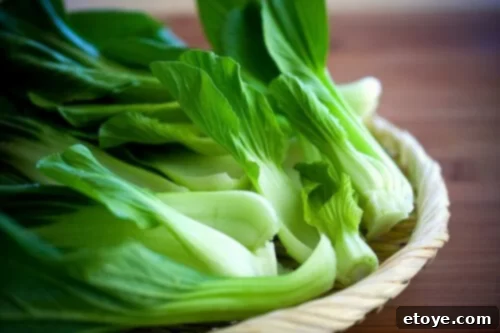
Health Benefits of Bok Choy
Beyond its delicious taste, bok choy is a powerhouse of nutrition. It’s an excellent source of vitamins A, C, and K, which are vital for vision, immune function, and blood clotting, respectively. It also provides important minerals like calcium, potassium, and iron, contributing to bone health, blood pressure regulation, and energy. Low in calories and rich in fiber, bok choy supports digestive health and can be a great addition to weight management diets. Its antioxidant compounds also help combat inflammation and may reduce the risk of chronic diseases. Incorporating bok choy into your diet is a simple yet effective way to boost your overall well-being.
More Delicious Chinese Recipes to Explore
If you loved this bok choy recipe, you might enjoy exploring other vibrant flavors of Chinese cuisine:
- Chinese Broccoli with Oyster Sauce
- Chinese Eggplant with Spicy Garlic Sauce
- Chinese Greens (Yu Choy) Stir Fry
We hope you enjoy trying out this incredible Stir-Fried Bok Choy recipe. Its simplicity, speed, and exceptional flavor make it a true kitchen hero. Don’t hesitate to leave a star rating and share your thoughts in the comments below!
Bok Choy Stir-Fry Recipe
Author: Jaden Hair
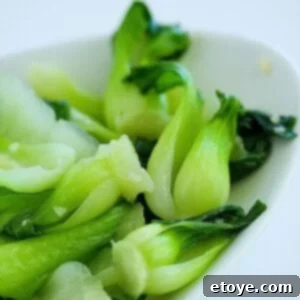
Rating: 4.84 from 67 votes
Quick Glance
- Prep Time: 5 minutes
- Cook Time: 10 minutes
- Total Time: 15 minutes
Dish Details
- Course: Side Dish
- Cuisine: Chinese
- Servings: 4 people
- Calories: 91 kcal per serving
Ingredients
- 1 1/2 pounds bok choy or baby bok choy
- 2 tablespoons cooking oil (canola, vegetable or peanut oil recommended)
- 2 cloves garlic, finely minced
- 1 teaspoon grated fresh ginger
- 3 tablespoons liquid (water, broth, or a combination including cooking wine)
- 1 teaspoon soy sauce (or salt, to taste)
- 1/2 teaspoon sesame oil
Instructions
- Trim the very end of the bok choy stems. Separate the leaves, keeping the tender inner centers intact. Wash and clean the bok choy thoroughly.
- Finely mince the garlic and grate the fresh ginger using a microplane grater to break up tough fibers.
- Place a wok or sauté pan on the stove. Pour in the cooking oil, then add the minced garlic and grated ginger. Turn the heat to medium-high. Allow the aromatics to gently sizzle until fragrant and light golden brown (this technique prevents burning).
- Add the bok choy leaves to the wok. Toss vigorously for about 15 seconds to ensure each leaf is coated with the garlicky, gingery oil.
- Pour in the liquid (broth, water, or wine). Immediately cover the pan and let cook for 1 minute to steam the bok choy.
- Remove the lid, season with soy sauce (or salt), and drizzle with sesame oil. Toss once more and serve immediately.
Nutrition Information (per serving)
- Calories: 91 kcal
- Carbohydrates: 4g
- Protein: 2g
- Fat: 7g
- Sodium: 195mg
- Potassium: 428mg
- Fiber: 1g
- Sugar: 2g
- Vitamin A: 7600IU
- Vitamin C: 77mg
- Calcium: 181mg
- Iron: 1.4mg
Keywords
bok choy, garlic bok choy, pak choy, stir-fry, Chinese greens, easy vegetable side
